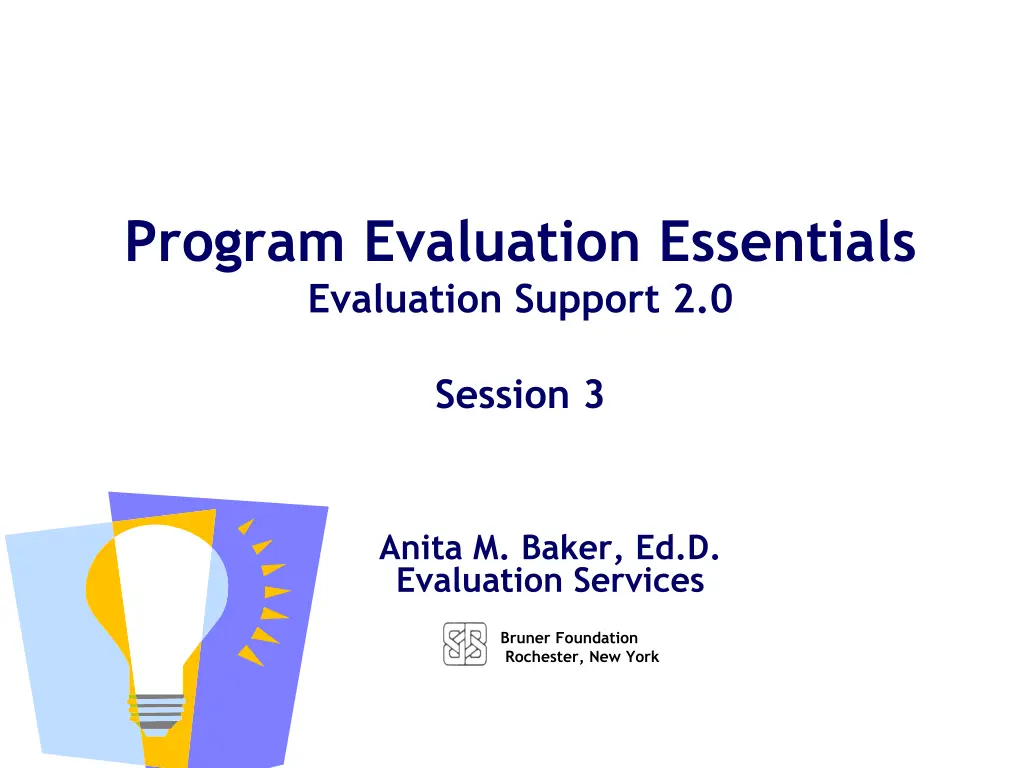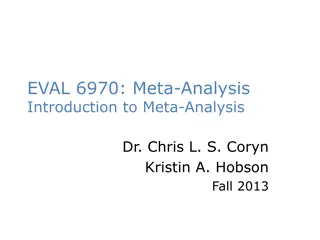
Conducting Effective Program Evaluation: Key Steps and Strategies
Learn essential steps in program evaluation including specifying key questions, data collection, analysis, and sharing findings. Explore how to plan analysis, handle missing data, and analyze quantitative data effectively.
Download Presentation

Please find below an Image/Link to download the presentation.
The content on the website is provided AS IS for your information and personal use only. It may not be sold, licensed, or shared on other websites without obtaining consent from the author. If you encounter any issues during the download, it is possible that the publisher has removed the file from their server.
You are allowed to download the files provided on this website for personal or commercial use, subject to the condition that they are used lawfully. All files are the property of their respective owners.
The content on the website is provided AS IS for your information and personal use only. It may not be sold, licensed, or shared on other websites without obtaining consent from the author.
E N D
Presentation Transcript
Program Evaluation Essentials Evaluation Support 2.0 Session 3 Anita M. Baker, Ed.D. Evaluation Services Bruner Foundation Rochester, New York
Evaluation Support 2.0 Sponsored by the Bruner Foundation www.evaluativethinking.org and Evaluation Services www.evaluationservices.co Free evaluation training and technical assistance focused on development of evaluative capacity including data analysis and reporting. Four (4), on-site, hands-on training sessions. Introduction to and use of free/low-cost tools to facilitate data entry, management and analysis. Guided evaluation project required. Virtual conference with funder, other organization participants. Bruner Foundation Rochester, New York Anita M. Baker, Evaluation Services
What do you need to do to conduct Evaluation? Specify key evaluation questions Specify an approach (evaluation design) Apply evaluation logic Collect and analyze data Summarize and share findings Bruner Foundation Rochester, New York 1 Anita M. Baker, Evaluation Services
What happens after data are collected? Data are entered, managed and analyzed according to plans. Results/findings are summarized. 1. Findings must be converted into a format that can be shared with others. 2. Action steps should be developed from findings. 3. Now that we know _____ we will _____. Bruner Foundation Rochester, New York 2 Anita M. Baker, Evaluation Services
Plan your Analysis in Advance! What procedures will be conducted with each set of data and who will do them? How will data be coded and recoded? How will data be disaggregated (i.e. broken out for example by participant characteristics, or time). How will missing data be handled. What analytical strategies or calculations will be performed (e.g., frequencies, cross-tabs). How comparisons will be made. Whether/which statistical testing is needed. Bruner Foundation Rochester, New York 3 Anita M. Baker, Evaluation Services
Analyzing Quantitative Data Important Things to Look at or Summarize Example Questions You Could Answer How many participants were in each group? What were the demographics of participants? How many answered Yes to Question 2? What to Do What That Means Count how many there are of something. Calculate Frequencies Count how often something (e.g., a response) occurs. What proportion of participants met intensity targets? Frequency/total *100 Calculate Total and/or Valid Percentages What proportion of all those who answered question 2, said Yes. Bruner Foundation Rochester, New York 4 Anita M. Baker, Evaluation Services
Analyzing Quantitative Data Important Things to Look at or Summarize Example Questions You Could Answer What to Do What That Means Calculate the average (mean),or identify the median (middle) or mode (most common value). What is the average number of hours participants attend? Determine Central Tendencies Avg. = What is the most common numbers of days attended in a week? (mode) Sum of Values Total Number of Values Total # of hours Total # of people with hours Bruner Foundation Rochester, New York 5 Anita M. Baker, Evaluation Services
Analyzing Quantitative Data Important Things to Look at or Summarize Example Questions You Could Answer What to do What That Means Determine Distributions What was the least amount of attendance for the group? What was the most? Determine the minimum value, the maximum, and/or how the data are grouped How many participants fall into low, medium, and high intensity groups? (e.g, high, medium, or low values, quartiles, percentiles, etc.). Are there relationships between participant characteristics and outcome changes? Cross-Tabulations (pivot tables are crosstabs) Relationship between 2 or more variables (also called contingency analyses, can include significance tests such as chi-square analyses) Bruner Foundation Rochester, New York 6 Anita M. Baker, Evaluation Services
Measuring Change or Difference Sometimes analysis focuses on change between two (or more) points in time and/or on differences between results. Example Questions You Could Answer What to Do What That Means Difference between two NUMBERS Calculate percentage change or percentage difference How much did the program grow in terms of participants or dollars used or hours spent in year 2 vs. year 1? How different was site 1 from site 2 in terms of program hours? Calculate percentage point change Difference between two PERCENTAGES Which site had proportionally more students who achieved outcomes? Did the proportion of students getting the correct answer change over time? Conduct means testing or chi square analyses Use tests to determine if results are statistically different (means tests such as t tests or ANOVA for numbers, chi square commonly for percentages) What is the probability that observed differences are due strictly to chance? 7
Analysis Plan Specifics, You Must Decide . . . What procedures will be conducted with each set of data and who will do them? How will data be partitioned? What types of codes will be applied to the data? How will comparisons be made? Data to other project data (within group) Data to expectations Data to data from other sources (across groups) There is no single process! Bruner Foundation Rochester, New York 8 Anita M. Baker, Evaluation Services
Steps to Take When Analyzing Qualitative Data 1. Segment or partition data (i.e., divide it into meaningful analytical units) 2. Reduce data Code data Compare data Process is Iterative 3. Organize, summarize and display data 4. Draw conclusions, verify/validate results 5. Revise summaries and displays accordingly Bruner Foundation Rochester, New York 9 Anita M. Baker, Evaluation Services
Coding Qualitative Data 1. A priori or deductive codes: predetermined categories based on accepted theory or program knowledge 2. Inductive: based on raw data (not predetermined) 3. Hierarchical: larger categories with subcategories in each You can combine inductive and deductive within a hierarchical coding scheme Bruner Foundation Rochester, New York 10 Anita M. Baker, Evaluation Services
Enumeration A strategy for organizing, summarizing, and displaying qualitative data Quantify frequency of codes,* or types Use counts to define results (e.g., most responses were positive; all responses fell into 4 categories the category most exemplified was __________). * e.g., none, some, a lot, as a percentage Bruner Foundation Rochester, New York 11 Anita M. Baker, Evaluation Services
Coding Strategies and Reminders 1. Keep a master list of codes Distinguish a priori and inductive codes Re-apply codes to all segments 2. Use multiple codes, but keep coding schemes as simple as possible 3. Test out sample entries to identify potential problems before finalizing code selections 4. Check for inter/intra coder reliability (consistency) Coding is not exact (expect differences) Co-occurring codes (more than one applies) Face-sheet codes (descriptors) Bruner Foundation Rochester, New York 12 Anita M. Baker, Evaluation Services
General Characteristics of Effective Tables and Graphs The table or graph should present meaningful data. The data should be unambiguous. The table or graph should convey ideas about data efficiently. Bruner Foundation Rochester, New York 13 Anita M. Baker, Evaluation Services
Thinking About Tables and Figures Tables are organized as a series of rows and columns . The first step to constructing a table is to determine how many rows and columns you need. The individual boxes or cells of the table contain the information you wish to display. Bruner Foundation Rochester, New York 14 Anita M. Baker, Evaluation Services
Thinking About Tables and Figures Tables must have a table number and title (be consistent). Where possible, use the title to describe what is really in the table. Table 1: Percent of Respondents Agreeing with Each Item in the Customer Satisfaction Scale. All rows and columns must have headings. It should be clear what data are displayed (n s, %s) You don t have to show everything, but a reader should be able to independently calculate what you are displaying. Clarify with footnotes if needed. Use lines and shading to further emphasize data. Bruner Foundation Rochester, New York 15 Anita M. Baker, Evaluation Services
Thinking About Tables and Figures Figures, which include graphs/charts and pictures or any other visual display also must have a figure number and title (be consistent). Like tables, use the title to describe what is really in the figure. Figure 1.3 Exit Status of 2006 Domestic Violence Program Participants. For bar and line graphs, both the X and Y axes must be clearly labeled. The legend, clarifies what is shown on the graph. You can also add individual data labels if needed. For any bar or line graph with multiple data groups, be sure to use contrasting colors that are printable in black and white. Bruner Foundation Rochester, New York 16 Anita M. Baker, Evaluation Services
Rules for Pie Charts Avoid using pie charts Use pie charts only for data that add up to some meaningful total Never use three-dimensional pie charts Avoid forcing comparisons across more than one pie chart. Bruner Foundation Rochester, New York 17 Anita M. Baker, Evaluation Services
Pie Charts Show Composition of a Whole Group Bruner Foundation Rochester, New York 18 Anita M. Baker, Evaluation Services
Rules for Bar Graphs Minimize the ink. Do not use 3-D effects. Sort the data on the most significant variable. Use rotated bar charts (i.e., horizontal) if there are more than 8 10 categories Place legends inside or below the plot area Keep the gridlines faint. With more than one data series beware of scaling distortions. Bar charts often contain little data, a lot of ink and rarely reveal ideas that cannot be presented more simply in a table. Bruner Foundation Rochester, New York 19 Anita M. Baker, Evaluation Services
Title Figure 1: Mean Tuition & Fees, Per Semester Illinois Public Universities, 2001 Data Label Legend Undergraduate Graduate $6,000 Grid Line $5,000 Graphical Elements $4340 $4,000 $3710 $3387 Y-axis scale $3,000 $2,000 $1,000 X-axis label $0 UIC NIU ISU EIU UIS CSU Bruner Foundation Rochester, New York 20 University X-axis title
Bar Graphs Show Frequencies Vertical or Horizontal Percent of CSI Participants with High Attendance (100 or more hours), by Year 60% 50% 45% 40% 35% 2007-08 28% 30% 2008-09 18% 20% 10% 0% New Schools Existing Schools Bruner Foundation Rochester, New York 21 Anita M. Baker, Evaluation Services
Bar Graphs Show Frequencies Horizontal or Vertical Bruner Foundation Rochester, New York 22 Anita M. Baker, Evaluation Services
Bars Can Be Stacked to Show Distribution Use with caution especially when there is no implicit order to the categories. Stacked bar charts work best when the primary comparisons are to be made across the data series represented at the bottom of the bar. Bruner Foundation Rochester, New York 23 Anita M. Baker, Evaluation Services
Figure 3: Survey Results: Percent of Principals Who are Satisfied with 6th Grade Literacy Achievement at Community Schools and Comparison Schools 100% 80% 60% 97% 40% 66% 75% 20% 23% 0% Community Schools Comparison Schools Project Schools (n=55) n=12 Comparison Schools (n=44) n=13 Satisfied Somewhat Satisfied Not Satisfied Bruner Foundation Rochester, New York 24 Anita M. Baker, Evaluation Services
Line Graphs Show Change Over Time Figure 6.7 Proportion of Students Passing Proficiency Test 100% 80% 60% 40% 20% 0% 04 05 06 07 Other SURR Schools Bruner Foundation Rochester, New York 25 Anita M. Baker, Evaluation Services
Evaluative Thinking
E-Surveys Key Decisions Why use an e-survey rather than a hard-copy survey/ intercept survey/ alternative survey or other data collection strategy? What question types do you need? How will they be displayed? Do you need an other field? Should they be required? Bruner Foundation Rochester, New York 1 Anita M. Baker, Evaluation Services
Before You Create an E-survey Strong items Administration plan Analysis plan Respondent experience Bruner Foundation Rochester, New York Anita M. Baker, Evaluation Services 2
Multiple Choice (only 1 answer) Forced Choice Item(MO) Directions read: Mark One unless it is so obvious that is the expectation. Bruner Foundation Rochester, New York 3 Anita M. Baker, Evaluation Services
Multiple Choice (multiple answers) Multiple Response Item (MATA) Multiple response items often create analysis challenges. Use sparingly. Bruner Foundation Rochester, New York 4 Anita M. Baker, Evaluation Services
Comment/Essay Box/Open-ended Bruner Foundation Rochester, New York 5 Anita M. Baker, Evaluation Services
Matrix of Choices (1 answer/row vs. multi answers/row) Bruner Foundation Rochester, New York 6 Anita M. Baker, Evaluation Services
Likert/Rating Scale Not at all important Slightly important Somewhat important Moderately important Extremely important Quality of ingredients Flavor Texture Brand A true Likert scale has 5 answer choices, and by the way it is pronounced Lick ert not Like ert. (The strategy was named for Rensis Likert who invented or popularized them.) Bruner Foundation Rochester, New York 7 Anita M. Baker, Evaluation Services
Single Vs. Multiple Textboxes You must have an analysis plan for using these data. Bruner Foundation Rochester, New York Anita M. Baker, Evaluation Services 8
Numerical Textboxes You must have an analysis plan for using these data. Consider hard codes (e.g., 1/month, at least 6 times per year, etc.) and using single text boxes; or true numbers when they exist which can then be used in other calculations like averages. Bruner Foundation Rochester, New York Anita M. Baker, Evaluation Services 9
Printing a Survey From the design survey menu select Print Survey Bruner Foundation Rochester, New York Anita M. Baker, Evaluation Services 10a
Printing Surveys Then Click here This will generate a Survey in PDF format. Bruner Foundation Rochester, New York Anita M. Baker, Evaluation Services 10b
Evaluative Thinking
Survey Response Collector Types Types of collectors: Weblink; Email Tracker; Facebook/Website Post; Manual Data Entry* Bruner Foundation Rochester, New York Anita M. Baker, Evaluation Services 11
Weblink Collector Write your own cover email Dear Colleague, Recently you attended an Allied Against Violence training session provided by the Center for Anti-Violence Education and agreed to provide some follow-up feedback regarding your use of the materials and strategies. Please click on the following link to start the very brief follow-up survey. It should only take you a few minutes to respond and your answers will be kept confidential. All responses will be combined and summarized to inform CAE s continued work in this field. Thank you in advance for your assistance CLICK HERE https://www.surveymonkey.com/s.aspx Thank you pages (default or custom) Bruner Foundation Rochester, New York Anita M. Baker, Evaluation Services 12
Follow-Up and Track Responses Bruner Foundation Rochester, New York Anita M. Baker, Evaluation Services 13
Manual Data Entry: Two Strategies Data entry/use as a database Weblink Collector: (Fast/Easy) Advanced Settings: Allow more than 1 respondent per computer Survey End Page: Loop to start Bruner Foundation Rochester, New York Anita M. Baker, Evaluation Services 14
Analyzing Data Using Survey Monkey Key Skills Generating and using frequencies Bruner Foundation Rochester, New York 15 Anita M. Baker, Evaluation Services
Analyzing Data Using Survey Monkey Key Skills Generating and customizing graphics Exporting graphs and tables Bruner Foundation Rochester, New York Anita M. Baker, Evaluation Services 16
Bruner Foundation Rochester, New York Anita M. Baker, Evaluation Services 17
Analyzing Data Using Survey Monkey Key Skills Using Filters allows you to select data, remove missing data and use numerical analysis functions. Comparing data calculates cross-tabs Bruner Foundation Rochester, New York Anita M. Baker, Evaluation Services 18
Analyzing Data Using Survey Monkey Key Skills Using Filters: Filter by Q&A Bruner Foundation Rochester, New York Anita M. Baker, Evaluation Services 19
Using Compare Bruner Foundation Rochester, New York Anita M. Baker, Evaluation Services 20





















